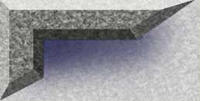|
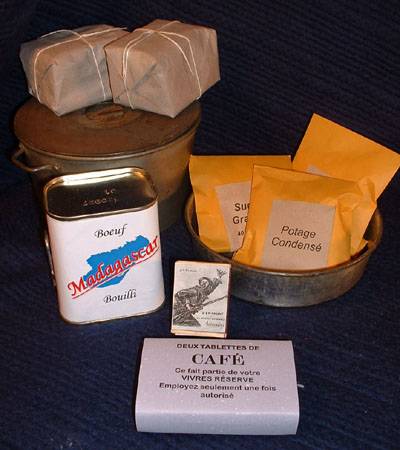
Each French soldier carried the 'vivres de réserve' (Reserve Food) ration in his pack. Even though orders existed not
to consume these until ordered, the French soldiers actually had more freedom to use their iron rations when the situation
dictated it then their British counterparts.
Standard
Reserve Food ration included:
2
Tins of Boiled Beef or Corned Beef. These tins were what gave the French Army it's peculiar name for meat tins, and even influenced
Doughboy and Tommy slang: Standard meat ration was the Madagascar brand 'Boeuf Bouilli'. The French soldiers assumed
with a name like 'Madagascar', it had to contain monkey meat, and, since then, all tinned meats in the French armed forces
are generally called "singe"-monkey (meat). The Tommys revived the old slang term for boeuf bouilli and gave the world the
term "Bully Beef", while US GI's also started calling processed meat "Monkey Meat". Generally, Madagascar brand came in tapered
tins, while some other meat brands/types came in both tapered and straight-walled rectangular tins. Even some stocks of captured
German meats ended up in French use, which generally had a bit of paper imprinted 'bouef' or 'porc' pasted to the top of the
lid. No matter what label the item bore, most every meat was known as 'singe'.
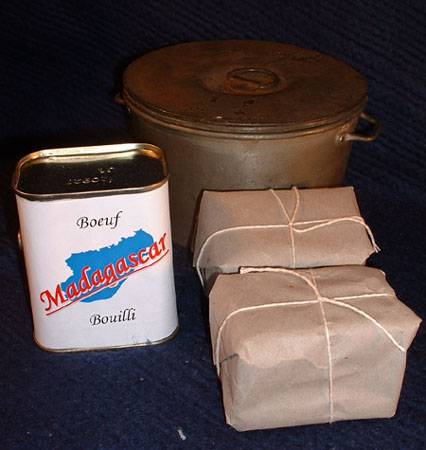
12 biscuits
(biscuits carrés--lit. 'Square Biscuits'-i.E. Hardtack). Normally these wereeither issued lose, or in two small packages
(especially later in the war). Total weight of biscuits issued was 200 grams (approx. 7 oz). These biscuits were first packaged in glued-shut wax paper wrappers (pre and early war), tin foil (late
war; after 1917) or cellophane wrappers (after 1916), and then wrapped in low-grade paper outer wrappers, which were string
tied. Pre-war and early war biscuits bore labels indicating contents, but after ration standardizations came into effect after
1915, the packs were unmarked, and only the outer cartons of 100 packs of biscuits bore any markings as to their contents
at all.
2
packets of dried soup. These packets were issued in quantities of 2, but 3 or more were frequently issued when advance projections
showed that re-supply with prepared foods was doubtful. Initially, these were boxed soup blocks of compressed or powdered
soup (various types, such as chicken noodle, vegetable or beef and rice), or small boxes of dry soup components (vegetables
and dry stock, or rice and dry stock). Later, this ration component came in standardized small envelopes containing either
bagged desiccated noodle soup or bouillon cubes (comprimés
de bouillon). All versions bore a war ministry label indicating content and the fact that they were part of the reserve food,
but generally no instructions for their use.
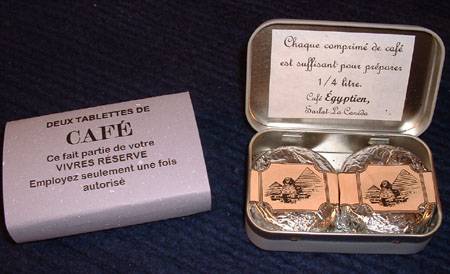
2
Coffee Tablets. These foil wrapped compressed lumps of regular or chicory 'ersatz' coffee were issued in small tin containers
with a paper sleeve indicating the contents and a warning to use only when ordered to do so.
The
tin was provided as the coffee tablets were just a foil wrapped lump with a paper label, and quite easily crushed or spilled.
The
coffee itself would then provided as a re-issue from a larger tin, and soldiers were urged to retain their tins for this reason.
Tins came in bare metal, light and dark gray, and a bluish hue resembling horizon bleu.
Most tins had instructions on how much coffee one could brew with each tablet (1/4 liter,
approx 8 ounces).
Soldiers,
of course, in many cases would just dump the coffee rations in a small canvas sack they kept inside their mess tins, and would
utilize the handy tins for keeping other vital things in, such as matches, tobacco or cigarettes.
Yes,
quite a few of these became part of trench-art projects, also...
2 issues of ration sugar,
also contained in paper envelopes similar to the ones used for soup. Early in the war, troops would get a small paper sack,
or a paper wrap of cubes, but after 1915, this ration generally was either granulated sugar (brown or white), or hard lump
rock candy. These packs also bore a label identifying the contents as part of the war ministry issued reserve ration.
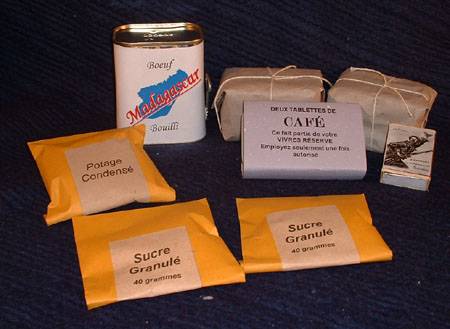
Better picture series coming
soon...
|
